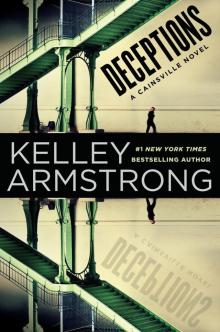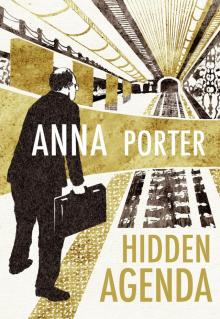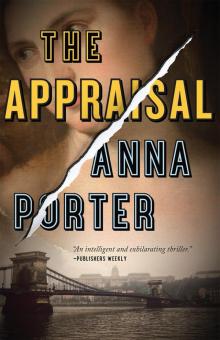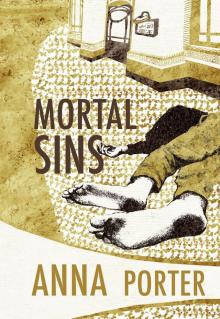- Home
- Anna Porter
Mortal Sins Page 2
Mortal Sins Read online
Page 2
His listed charitable activities included the United Jewish Welfare Fund, the World Wildlife Fund, the Jerusalem Foundation, the United Jewish Appeal, Canadian Aid to Refugees, and the Weizmann Institute.
Two children: Arthur, born 1961, and Meredith, born 1977.
Wife: Brenda. Research said she was born in Montreal in 1950, had a BA in English literature from McGill, and had married Zimmerman in 1975. Her main interest was shopping. There had been an earlier wife—1950 to 1973—name of Eva.
Zimmerman claimed no clubs and no interests. He went to great lengths to protect his privacy. He hated to be photographed and on one occasion had wrenched the camera from a photographer’s hands, torn out the film, and knocked the photographer to the ground in the ensuing struggle. The photographer had sued for assault. Zimmerman had settled out of court for a reported $150,000.
With Zimmerman’s gaunt frame now towering over him, Masters seemed ridiculously short and rotund. His meticulously cut vented dark blue jacket could not hide his bulging paunch. Judith bit her bottom lip till the pain overcame her desire to giggle. It was the thought of the two of them, side by side, striding into some momentous corporate meeting.
“Mrs. Hayes, if you wouldn’t mind,” Zimmerman said with a helpless shrug. “Perhaps Arnold could show you around the house while Philip and I go through these papers. I expect you’ll want to see the place, anyway.”
Arnold was already there, waiting for Judith. His pinched cheeks implied that he had several more important tasks to attend to and that, like Masters, he didn’t approve of journalists.
“Goodbye, Mrs. Hayes,” Masters called after them. “Please give my regards to Mr. Webster.”
A nice touch, that, considering that Webster owned the magazine Judith was writing this story for.
“Perhaps you’d like to see the gallery?” Arnold asked without enthusiasm. “Mr. Zimmerman collects Impressionists.”
“A good idea.” Judith much preferred Impressionists to pink marble.
It was the right decision. Zimmerman’s collection, though it had barely been mentioned in the press, was spectacular and, she suspected, one of the best in private hands. The paintings were displayed in a large oblong room, with a shimmering blue and gold patterned Oriental rug occupying the center. Each painting was lit by its own wall fixture, and each had a small brass plate for identification. Judith noted two Delacroix, one Degas, three Turners, some Corots, a green canvas by Odilon Redon, and several Monets. The Degas was a marvelous glowing blue ballet dancer bending over her shoe. The Gauguins were all early, except for a still life of khaki pears and orange cauliflowers on a pink plate.
Judith recorded them all in her notebook. “Has Mr. Zimmerman been collecting paintings for a long time?”
“Twenty years,” Arnold said. “These are not all of them. There used to be more.” He took a step back from Judith’s elbow and positioned himself near the bay window. She assumed he regretted speaking two sentences in a row.
“Maybe you would like to see the garden?”
She had read about that, too. Terraced, Italian, two artificial waterfalls turned on during the summer, a skating pond for the winter, three hills he had made for tobogganing, a warm pool with sauna and fake palm trees, Japanese lanterns at night. The whole thing was estimated to have cost $2 million. He had built it for his new wife, Brenda, apparently because she felt the woods that had originally occupied the space had blocked out the sun. Zimmerman himself, Judith had read, had taken to jogging three miles slowly around the garden each day, protected from public view by the tall stone fence and the electric wiring along the top of it. In the winter, the snow was removed from the paths in the mornings. The exercise, an unidentified friend had told Jensen, provided his thinking time. He made most of his investment decisions while on the run.
Judith joined Arnold at the window. “Must be beautiful in the summer,” she said.
“Mmm,” Arnold concurred. “If you would like to walk around...”
“I’d rather not,” Judith said firmly. “Much too cold now to appreciate it.” She picked up a finely painted statuette from the windowsill. It was handcrafted, the figure of a woman in peasant garb, her full skirt spread out around her ankles as she posed, her knees drawn up, her hands gathered around some flowers. She was a fragile light blue, with apricot cheeks; a tiny smile lit up her face. “She’s rather beautiful.”
“Zsolnay,” Arnold said. “From southern Hungary, near Pécs. Mr. Zimmerman has had a number of them brought over.” He took it from her and carefully replaced it. “They are rather valuable.”
“Really,” Judith growled. And here I was, about to smash it.
They were both saved from further conversation by Zimmerman. “My apologies again,” he said. “I wish one could predict every crisis.” He turned on another light that brightened the room to a gallery effect. “You like the paintings?”
“They’re beautiful. But why the Impressionists?”
“You think they’re too informal? They were very popular with dealers in the ’60s: a little risqué, yet still with recognizable shapes and forms—later they got most of us into abstracts. Except for Ken Thomson. He stuck with the old Krieghoffs, crafty devil.” He chuckled.
“No other reason?”
Zimmerman contemplated. “I like their sense of reality. No pretense at an ordered universe. No symmetry of design. They painted their impression of the truth—as they saw it. With some collusion by the viewer, who was left to inject his own interpretations. Look at this woman of Degas; she has a perfectly blank face. You and I are forced to imagine who and what she was.”
He seemed amused by the trouble Judith was having, balancing her notebook on the crook of her left arm, while her right hand tried to keep up with his patter.
“Have you studied art?”
“No,” she said, not wanting to remember her disastrous year in art history.
He had turned to one of the paintings, a small Renoir, and was closely examining the gold-leafed frame. “This has been chipped,” he said to Arnold, who was hovering nearby.
“I haven’t studied business either,” Zimmerman said with a chuckle. “Yet I seem to get by. Have you seen any of my buildings?”
“Of course,” Judith said. They dominated Toronto’s downtown skyline. “Everybody has.”
“They are like giant jigsaw puzzles with an almost infinite variety of pieces. The catch is to assemble them: first in your head, or you’ll never realize them in concrete and be there to collect the rent. In this business, you can’t make small mistakes, only big ones.”
He led her back into the hallway. “What’s your deadline?” he asked.
“Four weeks,” Judith replied, surprised by his change of tone.
“I’m afraid Philip was wrong. Our little signing session is likely to last a couple of hours, maybe longer. Can we resume another day?”
“When?”
“Perhaps you’d care to join us for dinner Sunday? A few friends are coming to celebrate with me.”
“What’s the occasion?”
He didn’t answer immediately. He stopped and turned and seemed to be thinking about the answer. His ice blue eyes were fixed, unblinking, on her face, with a gaze so intense and questioning she felt uncomfortable and looked away, over his shoulder to the incongruous glass case full of dead butterflies behind the Greek statue near the gallery entrance. Each butterfly was pierced through the center by a bright gold pin. The tiny incandescent wings glistened in the amber glow of the chandelier lights.
“A bit of a late birthday party,” Zimmerman said finally. “And I want you to be able to observe the man I have been. Otherwise the transformation would mean little to you.”
Two
THE FIRST PERSON TO arrive at Brandy’s on the 27th of February was Sylvia Hogarth, the 22-year-old newly hired waitress. Normally the owner-manager opened the doors himself, set up shop, checked the kitchen for supplies, and made sure of the morning deliveries of fresh m
eat and vegetables. But on the 26th he had asked Sylvia to work the extra couple of hours—on double pay—because he needed to spend the time in Greey’s office upstairs, attempting to negotiate a five-year lease renewal.
That was why it was Sylvia Hogarth who discovered the body.
The man lay on his side, in the alcove entrance to Brandy’s bar-restaurant, his head at an angle, against the door, his back curved around the bright orange lettering on the doormat. The letters stood out clearly on the photographs taken by the Identification Bureau: WELCOME.
His right arm was hooked around his chest. His left arm covered his face, the elbow pointing upward, as though he was trying to shut out the light. He wore a heavy navy blue woolen overcoat, a gray mohair scarf, and black rayon socks with old-fashioned garters.
In the beginning, Sylvia Hogarth had thought he was sleeping. Although the area around Brandy’s had long ago become a fashionable hangout, there were still a number of old derelicts around. No denying the proximity of Jarvis Street with its flop-houses, cruising whores, and charity homes for the needy. In winter some of the derelicts took refuge over hot air vents around the St. Lawrence Market a couple of blocks away; that was against the law, but the police didn’t bother them. Constable Peter Giannini from 52 Division had been known to slip them a dollar or two himself, as had Detective Inspector David Parr of Homicide. They both shopped at the market on Saturday mornings.
Sylvia Hogarth had waited for a few moments, she said, not knowing what to do, then asked the man politely to move on. When he didn’t respond, she nudged his foot, gently—“I barely touched him. Didn’t move his leg. No”—with the toe of her shoe. That’s when she noticed that he wasn’t wearing shoes. “It’s snowing, you know, and about 10 below, so I figured he can’t have been wandering around without shoes. Perhaps somebody stole them off him during the night. That’s what I thought. So I stepped over him and opened the door. His arm sort of flopped down and then I could see the blood on it.” She swallowed hard. “I’ve never seen a dead man before.” She looked over her shoulder toward the fancy doorway where the backup from 52 Division had cordoned off the scene for the photographer.
“You phoned then,” Parr prompted, patiently.
She shook her head. “I think I must have screamed, because a man heard me and stopped. He phoned the police. That’s him over there.” She pointed at a young man in an Irish knit sweater, now sitting under a floppy tropical tree at one of the window tables with Constable Angus Stewart, who was taking his statement.
Neither Sylvia Hogarth nor the owner-manager, who had been called down by now, had ever seen the dead man before. It had been difficult enough to convince Sylvia to look at the man’s face, and even when Giannini had succeeded, she would only glance at it for a second before she turned away, bringing her handkerchief to her lips. She thought she was going to be sick if they made her look again.
Parr wished other people in the area of Church and The Esplanade were as squeamish. They were all jostling for a better view, and the five uniformed men were having a tough time keeping them back.
Parr waited for the Identification Bureau to finish its work before he moved in for a closer look. Staff Sergeant Levine of the Criminal Investigation Branch had called him down after he had examined the body. Levine had thought there was something unusual about this homicide. And he had been right. Levine had a knack for spotting the interesting ones.
The most interesting thing about the dead man was that he was distinctly not one of the local derelicts. He was carefully and expensively dressed. The overcoat was brand new, or near as, dammit. His gray suit, Parr noted enviously, had the silk finish of one of Bill Brady’s best imported materials; his shirt was silk, too, and probably handmade, judging from the extra-wide cuffs held together by a pair of pearl cuff links with gold connecting pins. There was a squashed brown and blue check felt hat half hidden under the body, as if it had been thrown there before the man fell.
Strangely, he wore no shoes.
The third striking thing about him was the manner of his death. Two bullets had entered his body: one through the right temple, the other through the throat. Both shots had been fired at close range—the burn marks around the wounds testified to that. Either shot alone would have been fatal.
The damage to the back of the man’s head was terrible. A piece of his skull had been blown away by the blast, as had some of his brain. Parr guessed that the killer had used Remington-Peters bullets, the ones that explode on impact as the copper-sheathed nose peels back. But he would have to wait for the autopsy to verify that. What he didn’t have to wait to determine was that the body had been carried here from some other place and bundled into the doorway. There was barely enough blood to account for the bullet that had traveled through the neck, let alone the one that had exploded in the man’s head. Big pieces of skull and brains were missing.
“Well?” Levine asked, bending over Parr’s shoulder and gazing into the dead man’s open mouth. The lips were drawn back in a silent scream as if he had known he was about to be killed.
“A lot of gold fillings,” Parr said. He shut the eyelids over the staring black eyes, though he knew the pathologist wouldn’t like that. It was instinct mixed with some grudging respect for the dead. He stood and brushed the snow off his knees. He saw Levine was watching him expectantly.
“They’re on their way to pick up the body,” Levine said. “Anything else you want to check first?”
“I’d like to find the scene of the murder.”
Levine nodded vigorously. “I’ve already called the dispatcher, sir. More men are on the way.” It was only at times of great excitement that Levine called him sir, or when the Chief was around. They had known each other too long.
Again, Parr examined the man’s face. He was about 60 years old. The gray, sallow skin had taken on the texture of starched plastic as it sagged back from the cheekbones. The wrinkles under the eyes had bunched up in the outer corners as the muscles had relaxed. The hair had receded, though the man had gone to some trouble combing a few long strands over the top of his head.
The hands were wide and suntanned, a deep bronze color, in contrast to the whiteness of his face. A thin pale circle around the ring finger of his left hand showed that he had been wearing a wedding band. Parr lifted it gently to take a closer look at the cracked knuckle.
“Anything in the pockets?” Parr asked.
“No identification whatsoever, sir,” Levine replied.
“Nothing at all?”
Levine shook his head. “A bit of glass,” he said with a grin. He pulled open the dead man’s jacket. “There,” he said, pointing at the shirt pocket. A couple of tiny blood drops had frozen onto the outside of the pocket. When Parr bent over them he saw they were small pinpricks that had penetrated the shirt.
“Glass,” Levine said lightly. “Could make it easier for the boys to find the place where he’d been bumped off, wouldn’t you say?”
Parr grunted in agreement. Levine was good at his job. One day he’d make inspector. But what Parr wanted right now was a cup of hot coffee.
He asked the IB men to let him have a report by the end of the day. He figured Levine would hound the pathologist. He’d visit the coroner’s office himself tomorrow. He wished everyone a good morning and left for the St. Lawrence Market to see if Madame Roche still brewed the best coffee in the city.
Three
SINCE 10 A.M. THE LETTER had sat on the mantelpiece unopened. Judith had put it there right after succumbing to the old garden-variety feeling of greed that often possessed her at month’s end and snatching the mail directly from the mailman’s hand. There were three checks outstanding, and a tiny bonus from Reader’s Digest for rerunning an old story about her father, the closet bard. Only two of the checks had come, accompanied by an urgent note from Ma Bell about settling her overdue account. Then there was the letter with the Chicago postmark.
The handwriting was, unmistakably, James’s. The initials
had elaborate squiggles to disguise their identities, the middle letters were neatly rounded little morsels, upright and in perfect formation. Judith remembered when all of James’s writing had been like that, minutely controlled. Then he read, somewhere, that doctors were known for distinctive, though often illegible, handwriting and developed the ornate squiggles.
The last letter from James had been well over a year ago, and she had been sorry she ever opened it. He had attempted to give her advice about Jimmy’s adolescence, though he hadn’t seen the kid in two years. Judith suspected her mother had put him up to it—“the boy needs a father’s hand” and all that. Just because his marks were lousy.
The alimony payments came from a Bay Street legal office—in Canadian dollars and never on time.
Judith made herself coffee and scrambled eggs. Anxiety always made her ravenous. She searched, in vain, for the bacon, some ham, and even, in desperation, the cottage cheese she had purchased in deference to her diet. That the cottage cheese was gone surprised her most. Kids usually hated it.
She ate two slices of toast with real butter—another no on her low-calorie strategy, but she had a perfect excuse on the mantelpiece: she needed all the fortification she could find.
The plan for this morning had been to work quietly on her Zimmerman notes. Instead, she tidied the kitchen and stacked last night’s dishes, with the dinner plates grouped by color (the pink ones had come from James’s parents—they used to have little gold lines around the edges) and the peanut butter glasses on the bottom shelf (out of habit; it had been some years since Jimmy had to reach for a glass). In the Hayes house 1987 was supposed to be the year of the dishwasher, but it hadn’t happened yet.

 Deceptions
Deceptions Hidden Agenda
Hidden Agenda The Appraisal
The Appraisal Mortal Sins
Mortal Sins In Other Words
In Other Words